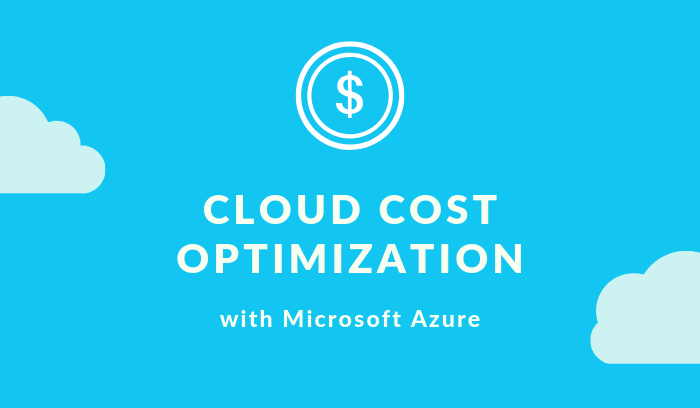Cost optimization can be a daunting task, especially when you have a large set of services in various environments. Some of the best practices for optimizing the cost of Azure Services are given below.
1. Right-Sizing VMs
In IaaS deployment it is a common theme to see oversized VMs, basically because we tend to provision the same VM size that we used to use in the on-premises environment. One recommendation to avoid such over sizing in Azure cloud is to use the Azure Migrate service’s performance-based assessments, which will give a good performance baseline for the cloud VM size and type. Plan your application with horizontal scaling in mind, that way we can add more instances when the demand rises and terminate when the demand decreases thus saving significantly on cost without compromising performance. Once you have deployed your environments the best practice is to enable monitoring an understand the VM utilization patterns. Azure Monitor and Application insights for Azure VMs can help to monitor the VM utilization.
Once the usage patterns are analyzed, we can select the optimal VM size. There is a broad variety VM series available in Azure. General purpose, Compute/Memory/Storage optimized, with GPUS and HPC series. Another variety in General purpose VMs are burstable VMs, that provide a low-cost option for workloads that typically run at a low to moderate baseline CPU utilization, but sometimes need to burst to significantly higher CPU utilization when the demand arises.
The VM sizes can be Scaled-Up or Scaled-Down омг онион (Vertical Scaling) after provisioning, but it requires restarting of the VM.
2. Purchasing Azure Reserved VM Instances (RIs)
Azure Reserved VM instances significantly reduce costs compared to pay-as-you-go prices—with 1-year or 3-year terms on Windows and Linux virtual machines (VMs). Combining Azure Reserved instances with pay-as-you-go prices, the infrastructure cost can be optimized across predictable and variable workloads.
3. Using Azure Hybrid benefits
The Azure Hybrid Benefit program allows the customers to bring their exiting Windows Server and SQL Server on-premises licenses with Software Assurance to Azure, thus saving big on the licensing cost. This also includes free extended security updates on SQL server 2008 and 2008 R2 workloads on Azure VMs.
4. Scheduling on/off times
Azure VMs uses per second billing, so one of the best ways to reduce your Azure cost is by scheduling start/stop of VMs in your non-production environments such as development, staging, QA etc. This could save you 60% – 70% of running this non-production instances. Automation solutions are available to Start/Stop VMs on schedules that can be configured on a per VM basis or based on tags, additionally automatic VM shutdown can be configured based on low CPU usage.
5. Azure Dev/Test Pricing
Azure provides discounted rates on services if you are using them for development and testing. Using leveraging Azure Dev/Test Pricing a Windows Virtual Machine can be run at the same rate as an Ubuntu/CentOs VM.
6. Upgrade instances to the latest generation
Azure introduces new generation of instances, so often, and thus tend to have improved performance and functionality compared to their predecessors. The option here is either upgrade existing instances to the latest generation or downsize existing instances with borderline utilization metrics in order to benefit from the same level of performance at lower cost.
7. Delete unattached disks and IPs
One of the general mistakes is to assume that when we delete a VM, the related resources such as data disks, IP addresses also deleted. When we delete the VMs the attached data disks or IPs does not get deleted, and they need to be identified and deleted. The azure Advisor service can help you identify unattached resources.
8. Delete orphaned snapshots, always have a retention policy
Most of the customers just want to make sure the backup is happening, without a proper plan or retention policy. If you have one and maintain the retention it is simply great! Otherwise the number will grow, and so your monthly bill. Usually, you just require the most recent snapshot to restore data if something goes wrong, and although snapshots don’t cost very much individually, you could save thousands of dollars by deleting those which are no longer required.
9. Terminate zombie assets
You need to keep an eye on unused assets and do frequent clean up. The common unused assets we usually find in new customer environments are Load Balancers, Traffic Mangers, IPs, Snapshots, Unattached data disks etc.
10. Move infrequently accessed data to lower cost tiers
Based on the data access frequency and redundancy considerations, you need to decide which tier is suitable for your use case. The savings generated from storing infrequently accessed, non-critical data in a lower cost tier can be substantial. Determining which storage tier is most suitable for data depends on factors such as how often data is accessed and how quickly a business would need to retrieve data in the event of a disaster.
Azure Blob Storage pricing provides premium, hot, cool and archive storage tiers (according to access frequency), and with several redundancy options such as LRS, ZRS and GRS,RA-GRS and GZRS (preview).
11. Use Spot VMs
With Azure Spot Virtual Machines (Spot VMs), you’ll be able to access unused Azure compute capacity at deep discounts, up to 90 percent compared to pay-as-you-go prices. Spot VMs are ideal for workloads that can be interrupted, providing scalability while reducing costs. Using Spot VMs allows you to take advantage of our unused capacity at a significant cost saving. At any point in time when Azure needs the capacity back, the Azure infrastructure will evict Spot VMs. Therefore, Spot VMs are great for workloads that can handle interruptions like batch processing jobs, dev/test environments, large compute workloads, and more.
12. Using Azure SQL Elastic Pools
SQL Database elastic pools are a simple, cost-effective solution for managing and scaling multiple databases that have varying and unpredictable usage demands. The databases in an elastic pool are on a single Azure SQL Database server and share a set number of resources at a set price.
Pools are well suited for a large number of databases with specific utilization patterns. The more databases you can add to a pool the greater your savings become.
13. Monitor, track and optimize your service offerings
You can use the Azure Monitor for collecting, analyzing, and acting on telemetry from your cloud and on-premises environments. It helps you understand how your applications are performing and proactively identifies issues affecting them and the resources they depend on.
Azure Advisor helps you follow best practices to optimize your Azure deployments. It analyses your resource configuration and usage telemetry and then recommends solutions that can help you improve the cost effectiveness, performance, high availability, and security of your Azure resources. By auditing the Azure Advisor recommendations, we can greatly optimize cost and improve security, performance and availability of the deployed solutions. Azure advisor recommendations can also be accessed from some specific services blades also, like Azure SQL databases, where performance recommendations like creating, deleting indexes, query parameterizations etc, can be accessed.
14. Analyze your costs and usage using the Azure Cost Management
Azure Cost Management is a free tool built into the Azure portal that help you understand Azure billing, manage your account and subscriptions, monitor and control Azure spending and optimize resource use. Using a set of default reports, you can quickly get started with identifying your underlying cost drivers and usage trends.
It is also suggested to look at your existing infrastructure architecture and make sure it’s highly available and scalable.
![]()





